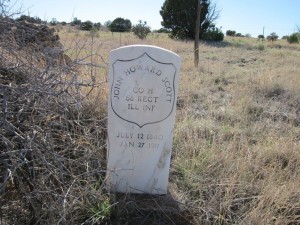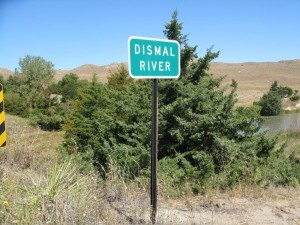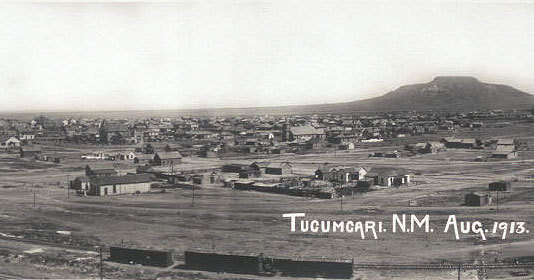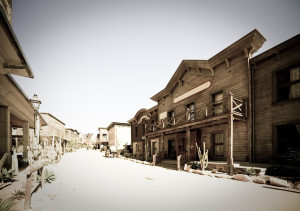Beverly Scott's Blog, page 15
August 14, 2015
“Journey to Fiction – Part 7″ by Bev Scott
This is the seventh and last in a serial documentation of the journey I have traveled from reading yellowed documents in the National Archives to launching a historical fiction novel based on the lives of my grandparents.
Please see the earlier blogs describing the journey to this point at bevscott.com/blog/.
New Mexico, Dugouts and the Decision to write a novel.
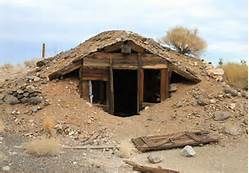 My grandfather, H.D. Scott died in Hanley, New Mexico January 27, 1911 at the age of 70 leaving my thirty-nine year old grandmother a widow with five children. Although I know that she eventually returned to Nebraska where her parents and several siblings lived, I am curious about her life in New Mexico especially since she was severely crippled with rheumatoid arthritis. I would like to find where my grandparents lived and my grandfather’s grave. I planned a trip to New Mexico.
My grandfather, H.D. Scott died in Hanley, New Mexico January 27, 1911 at the age of 70 leaving my thirty-nine year old grandmother a widow with five children. Although I know that she eventually returned to Nebraska where her parents and several siblings lived, I am curious about her life in New Mexico especially since she was severely crippled with rheumatoid arthritis. I would like to find where my grandparents lived and my grandfather’s grave. I planned a trip to New Mexico.
First stop is the Tucumcari Historical Museum. I learned almost immediately that my grandparents probably lived in a dugout given the time they arrived, 1910. As my research continued I learned that settlers at that time frequently arrived on the railroad with boxcars divided into one area for livestock and another for farm equipment and household belongings. Some also had a raised platform on one end for the family to eat and sleep during their journey. The Homestead Act had opened land to settlers for free as long as they lived on their land. The initial dwellings were frequently dugouts because they were cheap to build and didn’t require lumber and other building materials. Settlers were lured by the railroad who advertised the “choice farming” and clean air. But nothing was said about the low rainfall and the difficulty of finding water. Guessing that H. D. was attracted by the promises of a climate good for asthma and tuberculosis, I looked for land records of a homestead claim with no results. Because H.D. died a little over a year after they arrived and Ellen left for Nebraska they did not fulfill the requirement to live on the land for five years. I was out of luck in finding where they lived.
However, the museum staff helped me locate my grandfather’s grave which is now on private property. It is a white marker provided by the Veterans Administration with his birth name of John Howard Scott. Thirty years ago two of H.D.’s sons, my uncles, visiting his grave site discovered that the grave marker was broken and falling apart. Their request for a new grave marker from the Veterans Administration began the family search to learn more about H.D.’s life which I later took over and have chronicled in this blog series.
Although I could not find much information about where H.D. and Ellen lived, I was still intrigued by how Ellen, severely crippled, managed to get her five children back to Nebraska. Reviewing the National Archives documents, I found correspondence between the Pension Bureau and my grandmother. She submitted an application for widow’s benefits almost immediately after H.D. died. Then in the summer of 1911 she wrote that she would be going back to Nebraska and would send them her new address by September. One Government Agent’s report tells that they “drove all the way from New Mexico, where the soldier died, to her old home in Nebraska.” From our perspective today, it sounds like they “drove” a car. But I am sure they could not afford to have a car at that time so I assume they drove a horse and wagon which matches the family story that her older sons drove the wagon and she laid in the back as they made their way back to Nebraska.
I also learned from the Archives documents that the Government Agent who came in April of 1912 to interview my grandmother in person, filed a sensitive descriptive report of that meeting. She was living in a tent south of Thedford, Nebraska where she had filed a land claim. He reports that
“she hopes to establish a home for herself and children; but it looks like a most hazardous undertaking as she is practically an invalid because of rheumatism (sic), and her children are undersized puny looking little fellows, and they are more than a mile from the nearest water….In their present desolate surroundings their condition is pitiable in the extreme.”
Not only were Ellen’s circumstances dire and “pitiable in the extreme,” but they were a mile from the nearest water from a river aptly named, the Dismal River. It also appears that this was the occasion when she learned about H.D.’s first wife. The agent describes that
“until I informed her of the fact, claimant declares she had no knowledge of the existence of a former wife. Her grief and tears where convincing of the truth. She begged me not to tell anyone in her home neighborhood.”
The report, that she begs the Government Agent not to tell anyone, helps explain why no one in the family knew about H.D.’s first family, why my grandmother shared no information about him with her children and why she avoided answering any questions about him. I had exhausted my sources about H.D. and Ellen Scott.
This journey of the genealogical research uncovered a fascinating story that deserved to be told. But, there were several missing pieces. Although I had much to learn about writing fiction, historical fiction, I decided to write this story using what I had learned as the foundation for the story and creatively filling in the missing pieces.
June 17, 2015
“Journey to Fiction – Part 6″ by Bev Scott
This is the sixth in a serial documentation of the genealogical journey I have traveled from reading yellowed documents in the National Archives to launching a historical fiction novel based on the lives of my grandparents. Please see the earlier blogs describing the journey to this point at bevscott.com/blog/
Dear Readers to “A Journey to Fiction”,
I am back to writing again after five months. As some of you know, my family has suffered sadness and loss this year. I have wanted to be available, to be of support, to grieve and to find the path for the new ways of living our lives. Hence, the hiatus in my blog and my writing. I hope you enjoy the next installment below of “A Journey to Fiction”.
My grandparents, H.D. and Ellen Scott moved to Oklahoma in 1898 with three of their children. My father, the fourth son was born in Oklahoma in 1907. I described in Part 5 of this “Journey” my speculation about why they moved and what I was able to find in official documents about their lives. The correspondence I found in the National Archives reveal the deteriorating health of my grandfather as he is desperately trying to comply with requirements to receive Veteran’s Benefits from his service in the Civil War. From the documents, I learned that his doctor had urged him to move to a warmer climate than Oklahoma.
He spent the winter in Phoenix in 1909 living in a tent according to the Examiner who wrote, in April, 1909, “In view of his poverty and physical condition and the fact that he has a family of young children and that it is his desire to remove his family to some place in the Rocky Mountain region, a matter of large expense, I recommend that the claim be made special, especially since the examination may take considerable time. He is old and his condition is precarious.” He was 69.
The 1910 US Census lists the family residing in Quay County, New Mexico in the community of Hanley outside of Tucumcari. They must have moved after H.D. returned from Phoenix in 1909. But why? The only clue is his deteriorating health and the recommendation from the doctor that he move to a warmer climate. But why Quay County, New Mexico? I learned from additional research that the area around Tucumcari had been publicized as choice farming land. My grandparents and many others were probably tantalized by the railroad advertisements offering free land and clean air good for those ailing from tuberculosis and asthma. I suspect that H.D. suffered from asthma. With the hope of finding a farming paradise, a warmer climate and improved health, my grandparents moved to New Mexico. In August of 1910, a fifth child was born…a girl.
In April, 1909 the Examiner had reported that there were discrepancies in H.D. (alias John Howard) Scott’s statements. In reviewing the Archive documents, the deposition given by my grandfather reveals what those discrepancies were. He was shown evidence, in September of 1909 that the soldier John H. Scott was not known by any other name during his service, that he married Harriet Foncannon and that he lived with her for many years. Yet, H.D. claimed he had never married her. When asked which statement was true, he replied “I will not answer. I will not discuss the matter.”
Although my grandfather now going by Harvey Depew Scott denied his first marriage, the Examiner must have been convinced that he was really John Howard Scott who served in the Civil War. The Government finally approved the awarding of his pension. In December of 1910, in Hanley, New Mexico, a H.D. received his first pension check. He died one month later in January at age 70.
What does my thirty-nine year old grandmother do now that she is a widow with five children living in rural New Mexico? I know that my grandmother had severe rheumatoid arthritis from an early age. So she was not only a widow but probably disabled. I know she ultimately moved back to Nebraska but I wonder how she gets there and when she leaves Hanley. I want to know more about life in New Mexico and to find my grandfather’s grave. I planned another road trip to New Mexico.
May 10, 2015
The Stolen Girl by Zia Wesley
 Reviewed by Bev Scott
Reviewed by Bev ScottAn intriguing story that begins in Martinique as Aimee Dubuq du Rivery snuck off with her cousin Rose to hear their fortune told by an African Obeah predicting they will both be Queens. The author masterfully weaves this prediction into the story of Amiee who tries without success to enter Parisian society to find a husband and decides to become a nun. Sailing home before she enters the convent, she is abducted by pirates and is ultimately sold into the harem of the Sultan of Turkey. The character of Aimee is well developed as the reader experiences both her fears and her joys. In the first part of this totally engaging story, Aimee is conflicted by her actions which are violations of the rules of her Catholic faith but she ultimately adopts with utmost pleasure the culture and expectations of the Ottoman Sultan and Empire. The story moves at a lively pace and kept me enthralled to the end. The author provides excellent historical detail in the descriptions of Martinique, Paris and life in the Ottoman Sultan’s palace.
Author website: www.ziawesleynovelist.com/books.html
November 18, 2014
“A Journey to Fiction – Part 5″ by Bev Scott
This is the fifth in a serial documentation of the journey I have traveled from reading yellowed documents in the National Archives to launching a historical fiction novel based on the lives of my grandparents.
Move to Oklahoma; Claiming Veterans Benefits
My grandparents, H.D. and Ellen Scott were married in Thedford, Nebraska in 1892, purchased land from the Russell’s, Ellen’s family, and had three of their five children. I continued to review the documents I copied from the National Archives and discovered that H.D. filed for Veterans Benefits due to disability in 1897. According to the documents they moved to Dewey County, Oklahoma in 1898. Thomas County, Nebraska land records show they sold their Nebraska farm land back to the Russell’s in the same year. The family is listed in Oklahoma in the 1900 Federal Census.
By 1909, H.D. was living in a “canvas home (a tent with board siding) and ‘baching’” in Arizona, according to the documents filed by Pension Bureau Examiner. “He is evidently in very straightened circumstances…as a great sufferer from asthma.” He reportedly went to Arizona “two or three times to get relief from his affliction.” But, he left his wife and four children in Oklahoma.
Why Oklahoma? Was H.D.’s health already deteriorating in 1898? Alas there are no clues in the Archive documents.
Oklahoma was one of the last territories to be open for homesteading. Dewey County was Cheyenne and Arapaho Indian land. In 1892 it was opened for settlement. A search of homestead records however, does not show H.D. or Ellen filing a land claim in Dewey County between 1898 and 1910. During my road trip to Oklahoma, unfortunately, I did not get to the Dewey County Court House to review land records before they closed. But H.D. Scott and wife must have purchased land there, because later I discovered records in Thomas County, Nebraska that Ellen’s father and brother bought land in Dewey County, Oklahoma from Ellen and H.D. in 1901. Perhaps it is they who were investing in land in Oklahoma and H.D and Ellen purchased it and then resold it to them. I know from family lore that H.D. raised horses. Perhaps although his in-laws owned the land, H.D. raised his horses and settled his family there. Or more likely H.D. and Ellen needed the money.

As I mentioned, the family is listed in Oklahoma in the 1900 Federal Census. My father was born in Oklahoma in 1907. Recording of births did not begin in Oklahoma until October of 1908. I have a notarized statement from the woman who attended my grandmother when my father was born documenting the date and location. I also have a picture of the house in which he was born taken many years later in the 1950’s. When I visited Dewey County in search of his birthplace recently, the small town they lived near, no longer exists.
During the time the family lived in Oklahoma, my grandfather was trying to obtain his Veterans Benefits. The documents in the National Archives include correspondence regarding his deteriorating health. In April,1909 as mentioned above, he was living in a tent in Scottsdale, Arizona, a community of sick people, and according to the Examiner, was “favorably known considering the short time he has been there” (since November, 1908). By this time, he had filed three claims for Veterans benefits. My grandmother wrote to the Examiner when she sent her only pictures of him, “I do hope he will get his pension before it is too late.”
The Pension Examiner wrote in April, 1909, “In view of his poverty and physical condition and the fact that he has a family of young children and that it is his desire to remove his family to some place in the Rocky Mountain region, a matter of large expense, I recommend that the claim be made special, especially since the examination may take considerable time. He is old and his condition is precarious.”
However, due to “discrepancies in the soldier’s statements,” the Pension Bureau ruled that more investigation was required. I wanted to know how they investigated the discrepancies and if my grandfather received his pension before he died in January, 1911.
Have you done any genealogical research? What is your experience?
November 16, 2014
Energize Your Retirement by Christine Sparacino
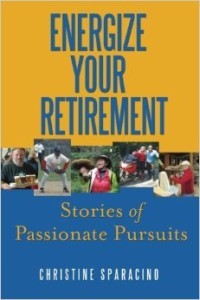 Reviewed by Bev Scott
Reviewed by Bev ScottChristine Sparacino has provided an invaluable resource for the multitudes of boomers who are entering their retirement years. The literature and the research on happy, satisfying and productive senior years endorse the importance of active engagement in a passionate pursuit for a longer and healthier life. In Energize Your Retirement, Sparacino has collected stories of passionate pursuits generously augmented with the detailed information and resources to help readers determine if a pursuit is right for them. Anyone thinking about “what will I do when I retire?” should read this book.
Sparacino has grouped her interviews into five sections which organize the book : Animals and Nature, Arts and Letters, Civic and Social Participation, Mechanics and Technology and Physical Activity and Sports. Animals and Nature include chapters on Astronomy, Bird Watching, Habitat Restoration, Mushroom Hunting, Service Dog Training and Beekeeping. In the chapter on “Beekeeper,” Sparacino offers fascinating information such as the history of bringing honeybees to the American colonies as early as 1622. Practical information also guides the potential beekeeper from zoning regulations, to how much time and money is involved. The beekeeper himself describes how he got started and what rewards he gains from this passionate pursuit. At the end of every chapter is an extensive list of resources to assist the interested retiree explore the pursuit.
In the Arts and Letters section, the author introduces a magician who learned magic to liven up his office presentations and carried his passion into retirement. The magician also shares information about how to learn magic, organizations to join and what makes a good magician. Sparacino shares interesting background information about the relationship of magic and psychology. Each chapter also includes a Fascinating Facts list about the chapter’s topic. Did you know that that Harry Houdini could pick up pins with eyelashes and thread a needle with his toes? Other chapters in this section include Calligraphy, Crossword Puzzles, Arts Usher, Fiction Writer and Stone Sculptor.
I knew the term “ombudsman” was Swedish defined as “one who cares for another, a citizen representative or advocate”. But, I didn’t know that the Swedish Parliament established the first independent ombudsman in 1809. You will find many such interesting tidbits in each of the chapters in the book. The Ombudsman chapter introduces a volunteer who is an ombudsman for elder care. Even if you are not interested in volunteering in this pursuit, you can learn a very helpful approach to figuring out what you want to do next after leaving your job or career. This volunteer ombudsman describes the training and certification she is required to take, what she does during a visit and how she works as an advocate with both sides of an issue. Believing that little things can make a big difference, this volunteer feels rewarded when she listens and feels trusted by both the elder and his or her family. Other chapters in this section on Civic and Social Participation include Disaster-Response worker, Medicare Counselor, National Park Volunteer, Nonprofit Board Director and Youth Mentor.
Space and tools are required to be a wood turner, one of the pursuits described in the section called Mechanics and Technology. A life-long interest led this retiree to prepare space on his property for woodworking, but he was really hooked after taking a class on woodturning before he actually retired. This chapter describes the basic tools needed, organizations to join and how to actually make a wooden bowl. The resources section lists websites, videos and classes to help the potential wood turner get started. If you are not interested in wood turning but would like to pursue something else a bit unusual or even common, you can read about Blogging, Home Brewing Beer, Operating a Ham Radio, Motorcycling, or RV Traveling.
The last section, Physical Activity and Sports offers stories from a Backpacker, Dancer, Softball Player, Target Shooter and a Triathlete. The Target Shooter will keep all of us from making stereotypical assumptions. A self-proclaimed workaholic and a vice president from a Fortune 100 company who retired at fifty five and with her husband took up target shooting. She is now certified as a pistol and rifle instructor. Sparacino gives us some interesting historical background of shooting competition in the US and in the Olympic Games. The story provides a breadth of information about this hobby from expenses, to clothes and equipment and training required. The story teller wants to let readers know that “target shooting is not about politics” but that it is a fun sport and an individual choice.
As the founder and creator of the positive aging program, “The 3rd Act”, I recommend this book as a “must have” resource for any boomers thinking about retirement. Even if your interests are not covered in this book, you will undoubtedly learn about approaches, resources and rewards that will help you in choosing your passionate pursuit in retirement.
I received this book from the author in an exchange for an honest review.
Author website: www.christinesparacino.com
October 14, 2014
The Burning of Uncle Tom’s Cabin by Carl Waters
Reviewed by Bev Scott
The title Burning of Uncle Tom’s Cabin is a metaphorical message of the author’s intent to destroy the negative and stereotypical portrayals of black people in the original Harriet Beecher Stowe’s Uncle Tom’s Cabin. Carl Waters points out in the Introduction, that although Beecher was less racist than many of her contemporaries in that she believe that black people had souls and that slavery was wrong, she believed in the superiority of white people and the inferiority of black people. For readers of Stowe today, this view is distorted and damaging.
Waters presents his own take on the original story, expanding the role of a minor character, George Harris, who refuses to accept that he is inferior or that he must remain a slave. The story is told from the point of view of George and his wife Eliza who are admirable and courageous characters. They take risks almost unimaginable for the sake of their love for each other and their son. The cruelty of George’s slave owner, Frank Harris, and viciousness of the slave catchers are vivid in Water’s descriptions bringing the reader in terrifying propinquity to the horror of slavery.
The story quickly drew me in and I journeyed beside both George and Eliza as they attempt to escape to Canada. At no point did the pace of their story lag nor did I lose interest in supporting their journey. At times the suspense was so high for me that I needed a break; but then I am considered a soft touch. At times the naiveté and trust of Eliza seemed unrealistic; however, since it probably comes from her protected and sheltered life as a “house slave”, it is more believable.
Burning Uncle Tom’s Cabin is the first of a four book series. Waters has met his goal of creating black characters of depth and confidence while exposing the inhumanity of the institution of slavery. He has also created a book with suspense, a compelling story and descriptions that give the reader a vivid experience of the journey George and Eliza traveled. In the end, Waters leaves the reader eager for his next book.
October 2, 2014
“A Journey to Fiction – Part 4″ by Bev Scott
This is the fourth in a serial documentation of the journey I have traveled from reading yellowed documents in the National Archives to launching a historical fiction novel based on the lives of my grandparents.
John Howard becomes Harvey D.

John Howard Scott disappeared from his home in Weatherford in 1879; and I could not find him in the 1880 US Census. Ten years later I found Harvey D. Scott living in Wyoming in 1890. The US Census records were destroyed by fire in 1890 but the National Archives had homestead records for Harvey D. Scott living in Glendo, Wyoming. In addition the 1890 Veterans Census showed a Harvey D. Scott in Laramie County, Wyoming. He had changed his name.
I theorized in my last “Journey to Fiction” post that he had joined a cattle drive headed to Dodge City. Some of the cattle drives continued north to Wyoming so perhaps he stayed with the drive as a cook and left the crew in Wyoming. I wanted to know more about his stay in Wyoming. I wanted to see where he homesteaded. Unfortunately, when I arrived in Wheatland, the county seat of Platte Wyoming, I discovered Glendo and the surrounding land is now under water from the Glendo Reservoir.
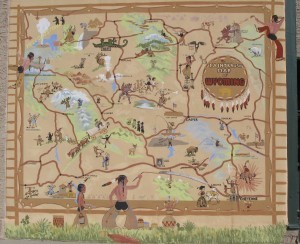 Not to be deterred, I went to the Platte County courthouse to look for land records. There I discovered that Harvey D. Scott paid the required filing fee of $18.00 and received 160 acres under the Homestead Act in approximately 1886. Now I knew that he had not only changed his name but he also identified himself as an unmarried man within seven years after he abandoned his wife Harriet and their children in Weatherford, TX.
Not to be deterred, I went to the Platte County courthouse to look for land records. There I discovered that Harvey D. Scott paid the required filing fee of $18.00 and received 160 acres under the Homestead Act in approximately 1886. Now I knew that he had not only changed his name but he also identified himself as an unmarried man within seven years after he abandoned his wife Harriet and their children in Weatherford, TX.
He “proved up” on this land, meeting the government requirements of living on the land, building a home and farming the land for five years. He received the land deed in 1892 and sold 40 of the 160 acres in 1893 for $450. From my earlier visit to Thedford, Nebraska, I knew that he had married my grandmother, Ellen in Thedford in 1892. Since she taught school in Wyoming, they must have met there. From my earlier explorations in Thedford, I had also learned Ellen and Harvey bought land from her brother and her father in 1892 and 1893 so perhaps the sale of Harvey’s land in Wyoming helped to pay for the Nebraska farm land. Ellen sold the remaining 120 acres in Wyoming after Harvey’s death for only $40. Perhaps it was so much less because there was less demand for land due to livestock losses in recent severe winters or the ending of the open cattle range in Wyoming. It is easy to imagine that my grandmother needed money in 1913 and sold it at a loss in desperation.
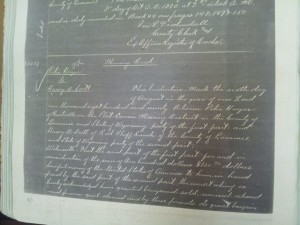
I continued to be amazed by what I found in the court house records. In 1890, Harvey D. Scott purchased a mining claim of 1500 feet in length and 300 feet in width for $100. He sold it less than a year later in 1891 for $5000! That is a successful investment. Perhaps he was getting ready to propose to my grandmother.
I had found my grandfather with a new name as an unmarried man homesteading in Wyoming seven years after he abandoned his family. I knew Harvey and Ellen were married in Thedford, Nebraska in 1892 and purchased land from her family. Their three oldest children were born there. Now I wanted to know why and when they moved to Oklahoma where my father was born in 1907.
September 18, 2014
“Confirmation of Our Plans for the Future” by Bev Scott
We were in the emergency room in the middle of the night. The admitting nurse told my spouse to stay in the waiting room as he motioned me into an examining room. I had awakened with my shoulder screaming in pain. When the pain was still severe a couple hours after taking mild over-the-counter pain medication, we decided to go to the ER at a nearby hospital.
The date for our move from our spacious Victorian flat to a modern condo complex was two weeks away. I had been focused for the last two months on organizing, downsizing, donating and packing. It was a daunting task to reduce thirty years of accumulated treasures, papers, books, furniture, and family mementoes sufficiently to fit into space that was half the size of our flat. I had been careful to pack into small size boxes and not lift anything too heavy. I didn’t think I had  done any serious damage but why was my shoulder so painful?
done any serious damage but why was my shoulder so painful?
“Who’s the woman with you?” I realized the nurse was speaking to me. “My spouse.” I replied. He quickly motioned to her to join us, realizing that married same-sex couples have the same hospital privileges as heterosexual married couples. Through the discussion with the nurse, the examination by the doctor and the report of the x-ray, we were treated with courtesy and respect as a couple. The doctor reported that I had overdone it…packed and moved too many boxes, carried items that were too heavy and repeated the motions of reaching and wrapping too many times. I had severe bursitis or tendonitis. My shoulder was immobilized and I left with prescriptions for a stronger painkiller and advice to see an orthopedist. Obviously this was not a major traumatic injury requiring hospitalization or surgery.
The experience was, however, enlightening and re-assuring. We were making this long planned move to smaller space with less maintenance, security, amenities and no stairs in preparation for our future. My spouse and I had both cared for and visited relatives who waited too long to move into space they could handle. Often they were forced to move by the realities of aging and illness and the pressure of adult children only to find themselves lonely in facilities they hated, suffering from the trauma and the loss of their home and without the comfort of familiar surroundings. Neither of us wanted that experience.
We wanted to move to a space we could take care of, feel secure to age in place and seek support as we needed it. We also wanted to live in our new space long enough to meet friends and establish community…a community of where we could both give and receive needed support in our aging lives. Having the support of “chosen family” and community is particularly important to those of us who came out as lesbian or gay  many years ago and experienced the rejection and hostility of biological family. Research reveals that many LGBT seniors live isolated and alone or go back in the closet when they enter an assisted care or nursing facility. We were being proactive now to create opportunities to build “chosen family” to take care of ourselves in the future.
many years ago and experienced the rejection and hostility of biological family. Research reveals that many LGBT seniors live isolated and alone or go back in the closet when they enter an assisted care or nursing facility. We were being proactive now to create opportunities to build “chosen family” to take care of ourselves in the future.
The nurse’s response in the ER, the final packing and experience of unpacking and getting settled in our new home, offered reassurance and highlighted the importance of the choices we had made. The nurse inviting my spouse to join me in the examining room demonstrated in a small but reassuring way the sea change of LGBT patient rights made possible through same sex marriage…having a loved one with us in the hospital. In the middle of the night, I could relax a little. I had an advocate, a second pair of ears and someone to provide comfort. More importantly, in the future when a hospitalization might be much more serious, we could be assured that we would be allowed to support, visit and comfort each other. In addition, with my injured shoulder limiting my mobility to pack and unpack, friends from our community stepped forward to help, demonstrating the value of building a community of supportive friends and chosen family who can step in to help when it’s needed in the future.
Originally published in The Transition Network Newsletter, July 15, 2014. www.thetransitionnetwork.org
August 18, 2014
“A Journey to Fiction – Part 3″ by Bev Scott
This is the third in a serial documentation of the journey I have traveled from reading yellowed documents in the National Archives to launching a historical fiction novel based on the lives of my grandparents.
On the Trail of John Howard Scott…
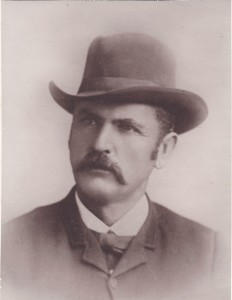
Grandfather as a young man before he abandoned Harriet.
I knew from the depositions I found in the National Archives, that John’s first wife Harriet reported he had abandoned her in 1879 leaving her “destitute” with five children and a sixth on the way. She believed he was dead. But I knew he lived until 1911 under the name of Harvey Depew Scott. Looking for clues, I combed the depositions he gave to government agents when he was trying to prove his identity as a Civil War Veteran.
There he acknowledged that he was in Kansas and in 1880 went to work as a cook for an “overland” expedition from Fort Dodge to Laramie, Wyoming. Another time he reported that he worked cattle. It was the time of cattle drives from Texas up to Dodge City. Thousands of longhorn cattle were driven by drovers up the Chisholm Trail and the Western Cattle trail. It is estimated that over five to six million cattle driven up the Western were packed into wooden railcars and shipped to Kansas City, Omaha, St. Louis and Chicago. 1880 was one of the peak years for cattle drives. Some cattle were to be delivered farther north and were driven across western Kansas to Ogallala, Nebraska, Dakota Territory, Wyoming, Montana and as far north as Canada.
Going from Texas to Dodge City at ten to fourteen miles a day easily took two to three months. Life on the cattle drive was dusty, lonely and frequently dangerous. Any strange noise or unexpected event especially at night could precipitate a stampede of the thousand to fifteen hundred skittish animals. Heavy rains meant flooded rivers and the trail drivers had to get reluctant cattle into rushing water, make sure none of them were carried downstream with a fast-moving current or got stuck in the quick sand at the river’s edge.
Cattle towns provided distractions and entertainment for the drovers. Dodge City was infamous as a wild and lawless town. A typical frontier town, it acquired a reputation of glamour, excitement and opportunity. Buffalo hunters, cowboys, gamblers, gun slingers and railroad men were drawn to Dodge City for thrill of adventure and easy come, easy go money.
Although killings didn’t happen every day, they were not a rare occurrence either. In the saloons where drinking, gambling and female entertainment occurred, and arguments among the rough characters who frequented these establishments were usually  settled by gun fights. The men shot dead were often buried in unmarked graves on famous Boot Hill. Wyatt Earp, his brother, Dave Mathers and other famous gun slingers and killers hung out in Dodge City.
settled by gun fights. The men shot dead were often buried in unmarked graves on famous Boot Hill. Wyatt Earp, his brother, Dave Mathers and other famous gun slingers and killers hung out in Dodge City.
Did John Howard join a cattle drive from Texas to Dodge City and then go on to Wyoming? Did the lure of Dodge City entice him north from Texas?
I believe there is a strong possibility he was in Dodge City or passing through during its rough and tumble days in the 1880’s.
June 10, 2014
“A Journey to Fiction – Part 2″ by Bev Scott
In my journey to uncover the family secrets about my grandfather, John Howard Scott, aka Harvey Depew Scott, I had discovered a trove of documents in the National Archives that confirmed the stories of another family. I had found information in Indiana searching in County records, libraries and cemeteries about John Howard’s parents, his birth, his Uncle Bill Swan and marriage to his first wife, Harriet. (see May 20 Blog) But, the National Archive documents indicated that the family had moved to Texas. In fact, a deposition from a Civil War soldier confirmed that his sister, Harriet, had married John Howard and that she lived at the time in Fort Worth, Texas. I wondered if I could find more information and learn when and why John and Harriet and their children moved to Texas. That led me on another leg of this journey.
 I began by exploring the census records. I discovered that in 1870 John and his family had moved to Illinois; but, in the 1880 census, John was not listed. Instead, Harriet is listed with six children living in Parker County, Texas. What happened to John and why was Harriet in Texas?
I began by exploring the census records. I discovered that in 1870 John and his family had moved to Illinois; but, in the 1880 census, John was not listed. Instead, Harriet is listed with six children living in Parker County, Texas. What happened to John and why was Harriet in Texas?
I turned back to the depositions. The government agents had tracked Harriet down in Fort Worth, thanks to her brother. In her deposition, she reported that the family moved to Weatherford, Texas, a small rural community in Parker County west of Fort Worth, but no hints as to why they moved to Texas. In November, 1879, John Howard had gone into town for a load of corn and never returned. Harriet said she was left destitute with five children and a sixth on the way. She looked for John tracking him to Fort Worth but ultimately lost the trail and assumed that he was dead. Five years later she had re-married and was running a boarding house in Fort Worth.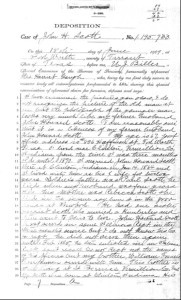
Following the census records also revealed three more generations of John Scott’s in Fort Worth, Texas, but no John Howard Scott. I wanted to know what had happened to him when he left Weatherford in 1879. Since I had found interesting information in libraries and historical societies in my search in Indiana and Nebraska, I decided the next stop in my journey was a visit to Texas.
I had no better luck than Harriet. I could find no trace of John Howard in Weatherford or in Fort Worth. He got out of town and left no trace. I did find in the Scott family plot in the Fort Worth cemetery and two of the three generations of John Paul Scotts. In the library, I found the obituary for John Howard’s son, J.P. Scott Sr., a “Pioneer in Business” who died in 1959 at age 92. It is Interesting that the obituary reports he moved to Fort Worth from Weatherford after his father died. J.P. founded his company in 1892, just three years after his father left the family. Originally the company served as a wagon yard selling firewood and awnings and shoeing horses. When he retired in 1938, his sons took over the business which then consisted of the Scott Awning Company and the Scott Rug Cleaning Company.
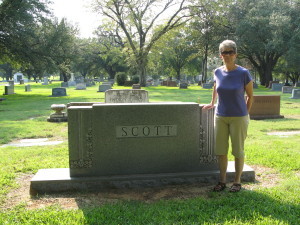 Where did John Howard go when he left Weatherford? When did he change his name to Harvey Depew Scott? What did he do between 1879 and 1892 when he married my grandmother? My journey and my search weren’t over yet. I still had many questions.
Where did John Howard go when he left Weatherford? When did he change his name to Harvey Depew Scott? What did he do between 1879 and 1892 when he married my grandmother? My journey and my search weren’t over yet. I still had many questions.
I would love to hear your stories researching your family.

